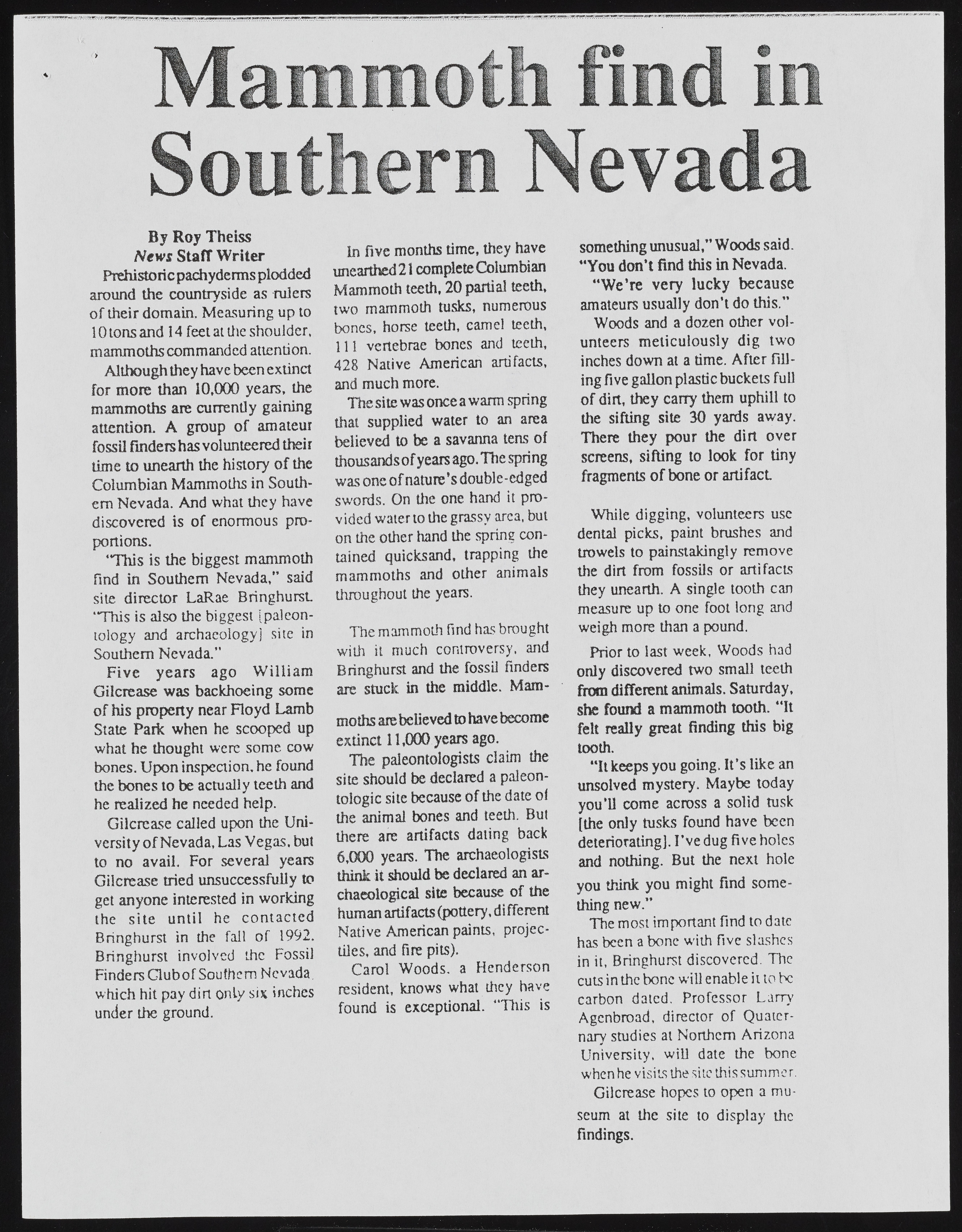Copyright & Fair-use Agreement
UNLV Special Collections provides copies of materials to facilitate private study, scholarship, or research. Material not in the public domain may be used according to fair use of copyrighted materials as defined by copyright law. Please cite us.
Please note that UNLV may not own the copyright to these materials and cannot provide permission to publish or distribute materials when UNLV is not the copyright holder. The user is solely responsible for determining the copyright status of materials and obtaining permission to use material from the copyright holder and for determining whether any permissions relating to any other rights are necessary for the intended use, and for obtaining all required permissions beyond that allowed by fair use.
Read more about our reproduction and use policy.
I agree.Information
Digital ID
Permalink
Details
More Info
Rights
Digital Provenance
Publisher
Transcription
It i!S>S Nevada By Roy Theiss News Staff Writer Prehistoric pachyderms plodded around the countryside as rulers of their domain. Measuring up to 10 tons and 14 feet at die shoulder, mammoths commanded attention. Although they have been extinct for more than 10,000 years, die mammoths are currently gaining attention, A group of amateur fossil finders has volunteered their time to unearth the history of the Columbian Mammoths in South* em Nevada. And what they have discovered is of enormous proportions. “This is the biggest mammoth find in Southern Nevada,” said site director LaRae Bringhurst "This is also the biggest ipaleontology and archaeology! site in Southern Nevada." Five years ago W illiam Gilcrease was backhoeing some of his property near Floyd Lamb State Park when he scooped up what he thought were some cow bones. Upon inspection, he found the bones to be actually teeth and he realized he needed help. Gilcrease called upon the University of Nevada, Las Vegas, but to no avail. For several years Gilcrease tried unsuccessfully to get anyone interested in working the site until he contacted Bringhurst in the fall of 1992. Bringhurst involved the Fossil Finders Clubof Southern Nevada which hit pay dirt only six inches under the ground. In five months time, they have unearthed 21 complete Columbian Mammoth teeth, 20 partial teeth, two mammoth tusks, numerous bones, horse teeth, camel teeth, 111 vertebrae bones and teeth, 428 Native American artifacts, and much more. The site was once a warm spring that supplied water to an area believed to be a savanna tens of thousandsof years ago. The spring was one of nature's double-edged swords. On the one hand it provided water to the grassy area, ’ on the other hand the spring contained quicksand, trapping the mammoths and other animals throughout the years. The mammoth find has brought with it much controversy, and Bringhurst and the fossil finders are stuck in the middle. Mammoths are believed to have become extinct 11,000 years ago. The paleontologists claim the site should be declared a paleon-tologic site because of the date of the animal bones and teeth. But there are artifacts dating back 6,000 years. The archaeologists think it should be declared an archaeological site because of the human artifacts (pottery, different Native American paints, projectiles, and fire pits). Carol Woods, a Henderson resident, knows what they have found is exceptional. “This is something unusual,” Woods said. “You don’t find this in Nevada. “We’re very lucky because amateurs usually don’t do this.” Woods and a dozen other volunteers meticulously dig two inches down at a time. After filling five gallon plastic buckets full of dirt, they carry them uphill to the sifting site 30 yards away. There they pour the dirt over screens, sifting to look for tiny fragments of bone or artifact While digging, volunteers use dental picks, paint brushes and trowels to painstakingly remove die dirt from fossils or artifacts they unearth. A single tooth can measure up to one foot long and weigh more than a pound. Prior to last week, Woods had only discovered two small teeth from different animals. Saturday, she fours! a mammoth tooth. “It felt really great finding this big tooth. “It keeps you going. It’s like an unsolved mystery. Maybe today you’ll come across a solid tusk (the only tusks found have been deteriorating]. I’ve dug five holes and nothing. But the next hole you think you might find something new.” The most important find to date has been a bone with five slashes in it, Bringhurst discovered. The cuts in the bone will enable it to be carbon dated. Professor Larry Agenbroad, director of Quaternary studies at Northern Arizona University, will date the bone when he visits the site this summer. Gilcrease hopes to open a museum at the site to display the findings.

